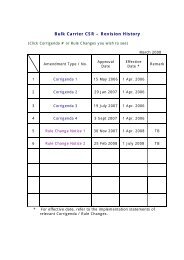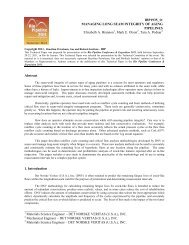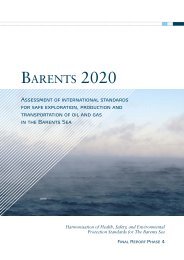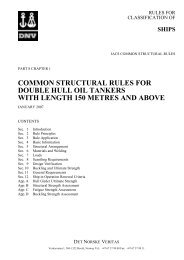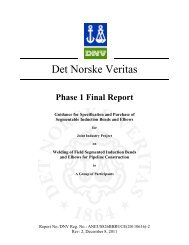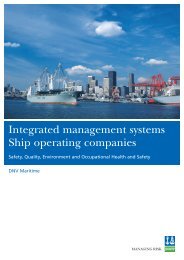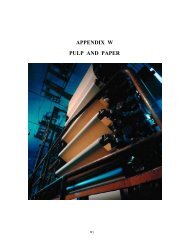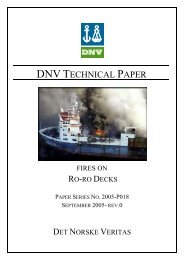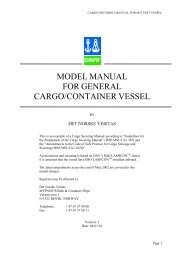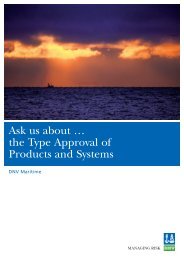InSitu Analysis of Pipeline Metallurgy - dnV
InSitu Analysis of Pipeline Metallurgy - dnV
InSitu Analysis of Pipeline Metallurgy - dnV
Create successful ePaper yourself
Turn your PDF publications into a flip-book with our unique Google optimized e-Paper software.
In-situ MetallographyIn-situ metallography is a process <strong>of</strong> performing a modified version <strong>of</strong> a laboratory metallographicsample preparation and examination under field conditions. Proper polishing and etching techniquesand interpretation <strong>of</strong> replicated surfaces is a key to success. One key difference between laboratoryand in-situ metallography is that laboratory procedures usually involve preparation and examination <strong>of</strong>cross sectional views <strong>of</strong> a pipe wall, whereas in the field, the preparation and examination is performedon the plane approximately parallel to and just slightly below the outside surface <strong>of</strong> the pipe. As aresult, through-thickness variations in the microstructure or crack morphology are not apparent in in-situmetallographic results. For example, stress corrosion cracking can initiate at the base <strong>of</strong> a mill flaw thatcauses a local stress concentration. However, the transition from mill flaw to SCC may be undetectedby metallographic examination <strong>of</strong> a prepared area that represents only a single plane parallel to andjust slightly below the pipe surface.The pipe surface is prepared by wet grinding small areas (i.e., a few square inches) <strong>of</strong> the pipe surfacewith a series <strong>of</strong> successively finer adhesive-backed abrasive discs mounted in a drill or similar powertool. The grinding typically finishes with 600 grit abrasive. Following the use <strong>of</strong> the abrasive discs, thesurface is polished with one or more diamond abrasive pastes, typically ending with a particle size nocoarser than about 6 micron. A final polish is obtained using either finer diamond abrasives or aluminaslurry. In all polishing stages the abrasive is normally applied to a small cloth disc that is once againmounted on and powered by a drill or similar power tool. During the grinding and polishing stages, caremust be taken to completely eliminate the scratches caused by the previous abrasive beforetransitioning to the next finer abrasive. Remnants <strong>of</strong> inadvertent cold working (superficial smearing) <strong>of</strong>the surface can be further minimized by etching the surface with nital or another etchant, followed byrepolishing with the finest abrasive, and then re-etching. Alternatively, surfaces may be electropolishedand then etched, although electropolishing can sometimes have a detrimental effect on some types <strong>of</strong>inclusions.After the final etching step, the surface can be viewed directly with a field-portable microscope, or thetopography <strong>of</strong> the etched surface can be replicated for viewing later at a laboratory (Figures 11 through13). Replication can be performed by a few different methods. Acetate film tape can be s<strong>of</strong>tened withacetone and then pressed against the etched surface and then peeled <strong>of</strong>f when it rehardens after a fewminutes. Alternatively, a castable resin (example, Struers “RepliSet” (3) system <strong>of</strong> fast curing two-partsilicone rubber) or proprietary replica foil consisting <strong>of</strong> reflecting plastic film with self-adhesive backingcan be used to replicate the etched topography <strong>of</strong> the prepared surface. The tape or casting can betransported to a laboratory and be viewed directly with a metallurgical microscope or can be coatedwith vaporized carbon and viewed with a scanning electron microscope. Resolution to 0.1 microns isachievable. Details <strong>of</strong> in-stu metallographic procedures are described in Reference 10.The Question <strong>of</strong> ToughnessToughness is a key input when determining the failure stress <strong>of</strong> planar flaws and in predicting leakversus rupture behavior. While toughness is normally measured in various types <strong>of</strong> destructive fracturetoughness tests or Charpy impact tests, efforts to estimate toughness via in-situ nondestructivemeasurements continues. Toughness is known to have qualitative relationships to pipe characteristicsthat can be measured nondestructively, including chemical composition, microstructure, and grain size.Quantitative relationships between composition and grain size in ferrite-pearlite steels have beenpublished, for example, Equation 4. 11(3) Trade name.TT = -19 +44(Si) + 7000(Nf 0.5 ) + 2.2(P) – 11.5 (d .-0.5 ) . (4)





